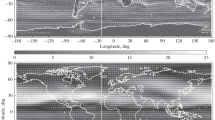Abstract
A primitive equation spectral model has been successfully integrated for five days starting with the initial data of 26 February 1982. The geopotential heights and wind strengths are well predicted up to day 3. The 24-hour accumulated precipitation of the model reasonably agrees only up to two days, with the observed rainfall under the influence of western disturbance that prevailed over Afghanistan, Pakistan and north India till 3 March 1982. For one day global integration of the model, the CPU time requirement in Cyber 170/730 is about one hour.
Similar content being viewed by others
References
Baede A P M, Jarraud M and Cubasch U 1979 Adiabatic formulation and organisation of ECMWF’s spectral model; Technical Report No. 15, European Centre for Medium range Weather Forecasts, Reading, U.K.
Bourke W 1972 An effective one level primitive equation spectral model;Mon. Weather. Rev. 100 683–689
Burridge D M and Haseler J 1977 A Model for medium range weather forecasting; adiabatic formulation; Technical Report No. 4, European Centre for Medium range Weather Forecasts, Reading, U.K.
Holloway J L Jr and Manabe A 1971 Simulation of Climate by a global general circulation model. 1. Hydrologic cycle and heat balance;Mon. Weather Rev. 99 335–370
Hoskins B J and Simmons A J 1975 A multi-layer spectral model and the semi-implicit method;Q. J.R. Meteorot. Soc. 101 637–655
Manabe S, Smagorinsky J and Strickler R F 1965 Simulated climatology of a general circulation model with a hydrologic cycle;Mon. Weather Rev. 93 769–798
Manabe S and Strickler R F 1964 On the thermal equilibrium of the atmosphere with convective adjustment;J. Atmos. Sci. 21 361–385
Phillips N A 1957 A coordinate system having some special advantages for numerical forecasting;J. Meteorol. 14 184–185
Robert A J 1966 The integration of a lower order spectral form of the primitive meteorological equations;J. Meteorol. Soc. Jpn. 44 237–245
Robert A J 1969 The integration of a spectral model of the atmosphere by the implicit method;Proc. WMO/IUGC Symposium on N W P (Tokyo: Japan Meteorological Agency) pp. VII–19-VII–24
Robert A J, Henderson J and Turnbull C 1972 An implicit time integration scheme for baroclinic models of the atmosphere;Mon. Weather Rev. 100 329–335
Smagorinsky J 1963 General circulation experiments with primitive equations; I. The experiment;Mon. Weather Rev. 91 99–164
Smagorinsky J, Manabe S and Holloway J L Jr 1965 Numerical results from nine-level general circulation model of the atmosphere;Mon. Weather Rev. 93 727–768
Author information
Authors and Affiliations
Rights and permissions
About this article
Cite this article
Dash, S.K., Chakrapani, B. Simulation of a winter circulation over India using a global spectral model. Proc. Indian Acad. Sci. (Earth Planet Sci.) 98, 189–205 (1989). https://doi.org/10.1007/BF02863244
Received:
Revised:
Issue Date:
DOI: https://doi.org/10.1007/BF02863244



